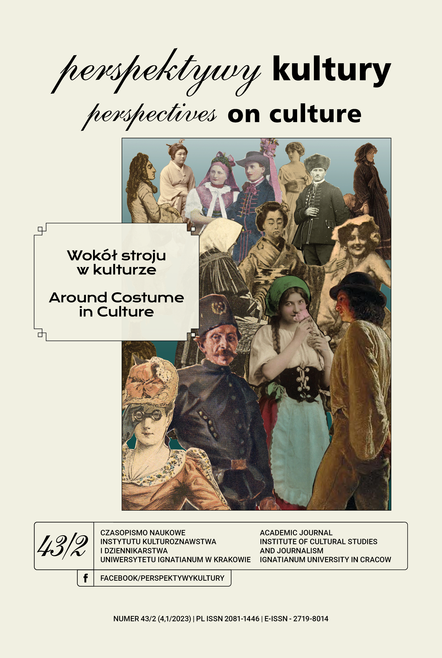The Kimono in Japanese Culture – from Dress to the Symbol of “Japa-neseness”
Abstract
The kimono stands out as one of the most recognizable forms that clearly communicates Japanese cultural affiliation. It is called a traditional costume, a national costume, and a symbol of “Japaneseness”. My research in Kyoto and Tokyo has shown that the kimono clearly serves as a mirror of the culture from which it originates. This includes its form and decoration, craftsmanship in its making, how it is worn, the cultural norms associated with it, and the social role it fulfills. Selected aspects are discussed using the example of women’s kimonos, taking into account the historical perspective. It provides valuable insights into cultural patterns and social interactions characteristic of Japanese culture.
The article highlights the fact that the kimono is a work of art “to be worn”, representing traditional Japanese craftsmanship of kōgei. It is an important cultural heritage, an object of daily life, a cherished artifact in museum exhibitions, and a source of inspiration for Japanese and Western artists. However, we must remember that during the Meiji period (1868–1912) it became a tool for reinforcing national identity, invoked in discussions about the uniqueness of Japanese culture.
The aim of this article is to emphasize the kimono as an integral part of Japanese culture, taking into account its artistic significance, the meaning of this form of dress as a symbol of “Japaneseness”, and a reflection on the interplay between the present and the past.
References
Bielak, A. (2019). Zrozumieć kimono. Kultura zaklęta w stroju. Kraków: Muzeum Sztuki i Techniki Japońskiej „Manggha”.
Bunka Gakuen Fukushoku Hakubutsukan (red.) (2005). 『日本服飾の美』(„Nihon fukushoku no bi, Masterpieces of Japanese Dress from the Bunka Gakuen Costume Museum”). Tōkyō: Bunka Gakuen Costume Museum.
Dalby, L. (2001). Kimono. Fashioning Culture. London: Vintage.
Frois, L. (1991).『ヨーロッパ文化と日本文化, Okada (red., tłum.). Tōkyō: Iwanami Bunko 岩波文庫 (oryginalny tytuł: Tratado em que se contem muito susintae abreviadamente algumas contradições e differenças de custumes antre a gente de Europa e esta Provincia de Japão (1585);『日欧文化比較 』).
Goldstein-Gidoni, O. (1999). Kimono and the construction of gendered and cultural identities. Ethnology, t. 38, nr 4, 351–370.
Hall, J. (2020). Japan beyond the kimono. Innovation and tradition in the Kyoto textile industry. London–New York: Bloomsbury Visual Arts.
Kaminski, E. (= Kamińska, E.) (2012). Rezeption japanischer Kultur in Deutschland: Zeitgenössische Keramik als Fallstudie. Kraków: Księgarnia Akademicka.
Kamińska, E. (2020). Kobiety wobec polityki – polityka wobec kobiet. Pozycja kobiet w społeczeństwie Japonii od okresu Meiji do współczesności. W: M. Banaś (red.), Kobiety w polityce. Sfera publiczna. Kraków: Księgarnia Akademicka.
Kyōto Kokuritsu Hakubutsukan (red.) (1999). 『花洛のモードきものの時代』Kyōto Style. Trends in 16th-19th Century Kimono. Kyōto: Kyōto Kokuritsu Hakubutsukan.
Milhaupt, T.S. (2014). Kimono: a modern history. Exhibition at the Metropolitan Museum of Art, New York. London: Reaktion Books.
Nitanai, K. (2017). Kimono design: an introduction to textiles and patterns. Tokyo–Rutland–Singapore: Tuttle Publishing.
Okubo, N. (2011). Kimono no Jiten. Dentō wo shiri, imayō ni kiru『着物の事典, 伝統を知り今様に着る』(„Leksykon kimona. Poznać tradycję i nosić ją w nowoczesny sposób”). Tōkyō: Ikeda Shoten.
Toriimoto, Y. (1998). 「安土桃山の小袖再現」(„Reprodukcja kosode z okresu Azuchi-Momoyama”). 『日本服飾学会誌』(Journal of the Japanese Institute of Costume), vol. 17, 148–158.
Toriimoto, Y. (2023). 『着物のルーツを探る』(„W poszukiwaniu korzeni kimona”). Materiały do zajęć w Kyōto Sangyō Daigaku z dnia 7.09.2023.
Valk, J. (2015). „The Kimono Wednesday” protests: identity politics and how the kimono became more than Japanese. Asian Ethnology, t. 74, nr 2, 379–399.
Valk, J. (2017). From Duty to Fashion: The Changing Role of the Kimono in the Twenty-First Century. Fashion Theory. The Journal of Dress, Body and Culture, t. 22, nr 3, 309–340. London–New York: Routledge.
Valk, J. (2021). Selling the kimono. An etnography of crisis, creativity and hope. London–New York: Routledge.
Zaborowska, B. (2004). Kimono. Jego dzieje i miejsce w japońskiej kulturze. Warszawa: Wydawnictwo Trio.
Fuzoku Hakubutsukan, https://www.iz2.or.jp (dostęp: 15.09.2023).
Copyright (c) 2023 Perspectives on Culture

This work is licensed under a Creative Commons Attribution 4.0 International License.
Autor, zgłaszając swój artykuł, wyraża zgodę na korzystanie przez Wydawnictwo Uniwersystet Ignatianum z utworu na następujących polach eksploatacji:
- utrwalania utworu w formie papierowej, a także na nośniku cyfrowym lub magnetycznym;
- zwielokrotnienia utworu dowolną techniką, bez ograniczenia ilości wydań i liczby egzemplarzy;
- rozpowszechniania utworu i jego zwielokrotnionych egzemplarzy na jakimkolwiek nośniku, w tym wprowadzenia do obrotu, sprzedaży, użyczenia, najmu;
- wprowadzenia utworu do pamięci komputera;
- rozpowszechniania utworu w sieciach informatycznych, w tym w sieci Internet;
- publicznego wykonania, wystawienia, wyświetlenia, odtworzenia oraz nadawania i reemitowania, a także publicznego udostępniania utworu w taki sposób, aby każdy mógł mieć do niego dostęp w miejscu i czasie przez siebie wybranym.
Wydawca zobowiązuje się szanować osobiste prawa autorskie do utworu.






